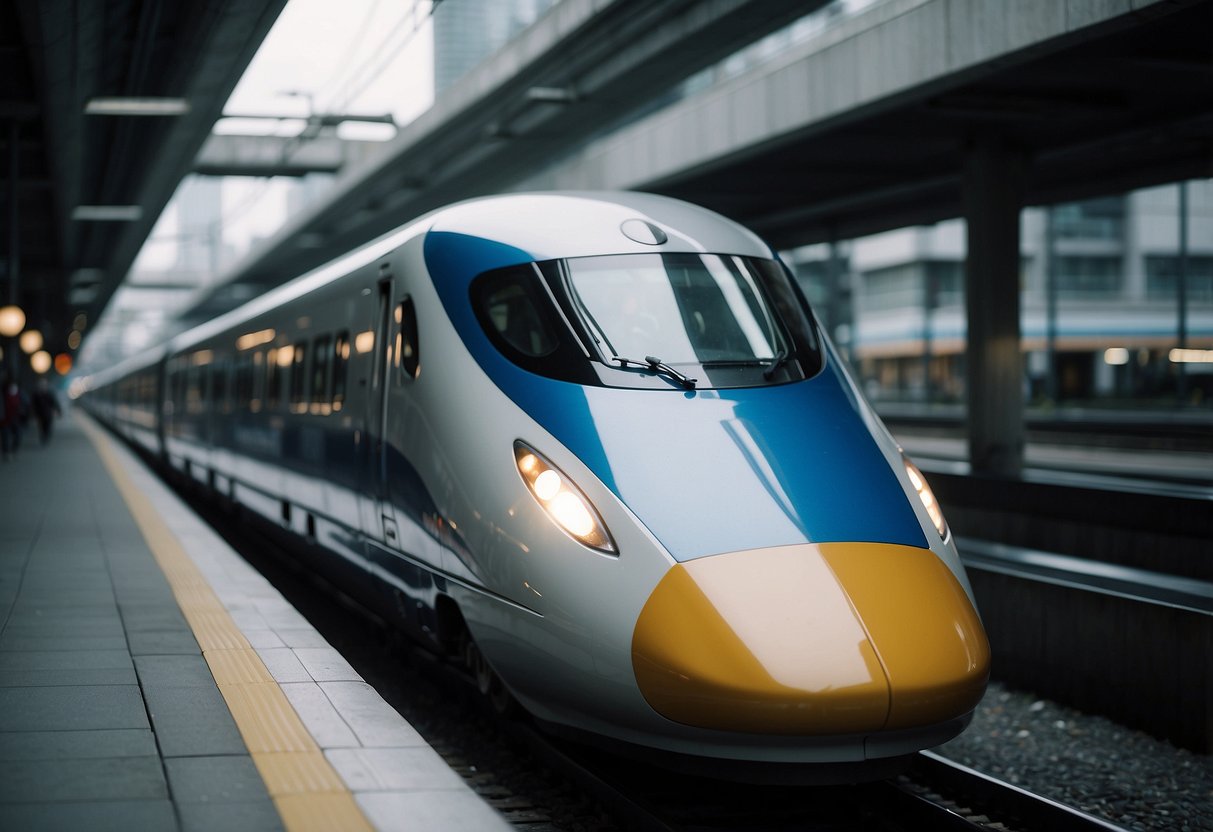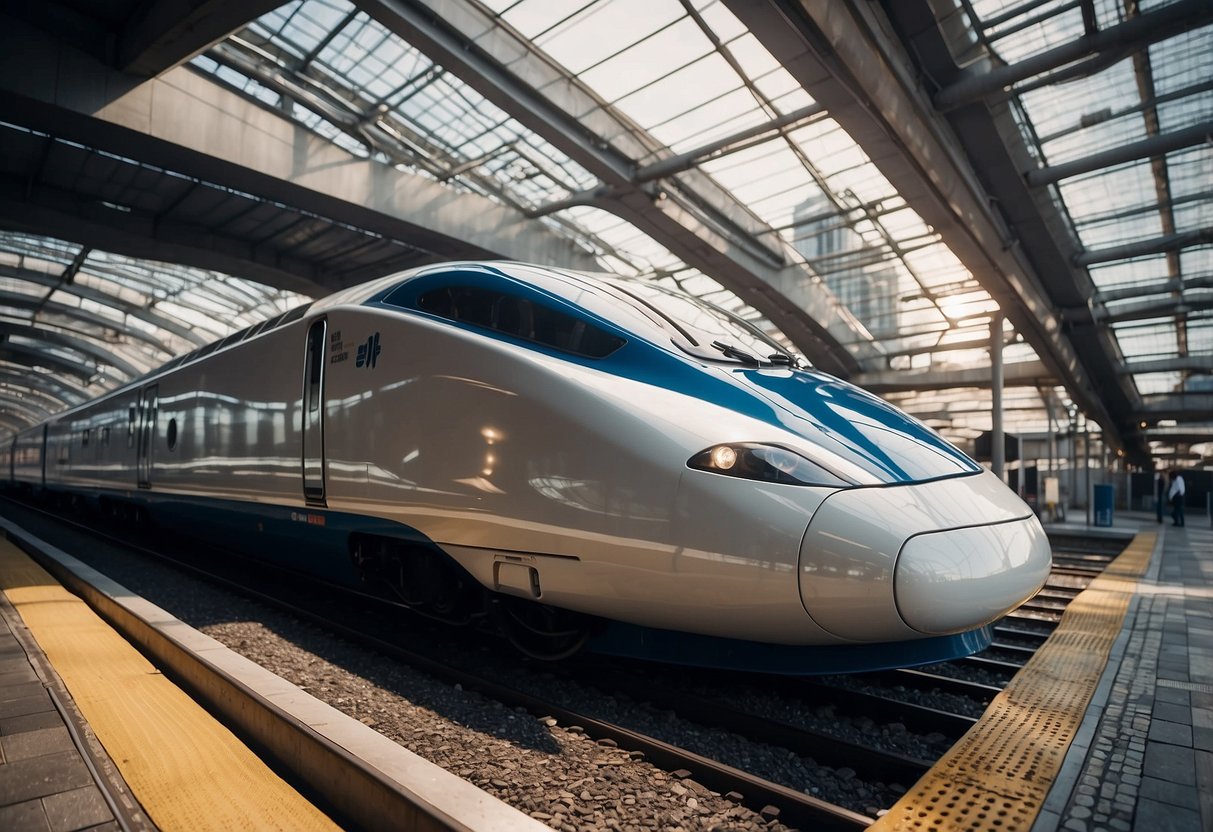Shinkansen trains, Japan’s iconic bullet trains, have long been synonymous with high-speed rail travel. These sleek marvels of engineering have captivated the world since their introduction in 1964, setting the standard for fast, efficient transportation.

While Shinkansen trains remain among the fastest in regular commercial service, they are no longer the absolute fastest in the world.
The fastest Shinkansen, the Hayabusa, reaches speeds of up to 320 km/h (200 mph) on certain routes.
This impressive velocity places it among the elite of high-speed trains globally, but other countries have developed systems that match or exceed this speed.
We find that the Shinkansen’s true strength lies not just in its speed, but in its unparalleled reliability, safety record, and frequency of service.
The Japanese bullet train network continues to evolve, with ongoing research into even faster trains, including maglev technology that could potentially reclaim the title of world’s fastest train in the future.
Table of Contents
Evolution and Advancements in Shinkansen Technology

Since its inception, Japan’s Shinkansen system has undergone remarkable technological progress.
We’ve seen continuous improvements in speed, safety, and design that have kept these bullet trains at the forefront of rail innovation.
From 700 Series to N700S: The Progression of Shinkansen Models
The 700 Series marked a significant milestone in Shinkansen development when it debuted in 1999. Its streamlined design reduced air resistance and noise, setting new standards for high-speed rail.
The N700 Series, introduced in 2007, brought further refinements. It featured improved acceleration, tilting technology for smoother cornering, and enhanced passenger comfort.
In 2020, the N700S became the latest addition to the Shinkansen fleet. This next-generation train boasts:
- Lighter weight construction
- Improved energy efficiency
- Advanced suspension for a quieter ride
- Lithium-ion battery system for emergency power
Cutting-Edge Speed: Shinkansen Trains in Comparison
Shinkansen trains have consistently pushed the boundaries of rail speed. The Hayabusa Shinkansen currently holds the operational speed record at 199 miles per hour (320 km/h) on the Tohoku and Hokkaido lines.
However, experimental models aim even higher:
- The ALFA-X prototype is designed to reach 224 mph (360 km/h)
- Japan’s maglev train has achieved 374 mph (603 km/h) in tests
While impressive, these speeds are balanced with strict safety considerations and infrastructure limitations.
Safety and Design Innovations
Safety remains paramount in Shinkansen design. Recent advancements include:
- Improved earthquake detection systems
- Automatic braking technology
- Reinforced car bodies for enhanced crash protection
Design innovations focus on aerodynamics and noise reduction. Long nose designs minimize tunnel boom, while pantograph covers reduce wind noise.
We’ve also seen advancements in passenger comfort, with ergonomic seating, reduced vibration, and improved air pressure regulation in tunnels.
The Shinkansen Network and Its Role in Japanese Travel
The Shinkansen network connects major cities across Japan, offering fast and efficient travel options. We’ll explore the extensive routes and the benefits of the Japan Rail Pass for visitors.
Expanding Horizons: Shinkansen Routes Across Japan
The Shinkansen network spans Japan’s largest islands: Honshu, Hokkaido, and Kyushu. The Tokaido Shinkansen, operated by JR Central, links Tokyo and Osaka, serving as the backbone of the system.
JR East manages the Tohoku Shinkansen, extending north to Aomori, and the Hokuriku Shinkansen, reaching Kanazawa. JR West operates the Sanyo Shinkansen from Osaka to Fukuoka.
The Kyushu Shinkansen, run by JR Kyushu, connects Fukuoka with Kagoshima. In 2016, the Hokkaido Shinkansen began service, linking Honshu to Hokkaido via undersea tunnel.
These routes have dramatically reduced travel times between major cities. For example, the journey from Tokyo to Osaka now takes just 2 hours and 30 minutes.
Accessibility and Convenience: Japan Rail Pass for Travelers
The Japan Rail Pass offers unlimited travel on most JR lines, including Shinkansen trains. This pass is exclusively available to foreign visitors, providing excellent value for exploring Japan.
Valid for 7, 14, or 21 consecutive days, the pass allows access to all Shinkansen except the fastest Nozomi and Mizuho services. Travelers can easily visit multiple cities like Tokyo, Kyoto, and Hiroshima.
We recommend purchasing the pass before arriving in Japan for the best price. It’s important to note that some routes, like the Tokaido Shinkansen, may require seat reservations during peak travel periods.
The Japan Rail Pass simplifies travel logistics and can lead to significant cost savings for those planning to explore multiple regions of Japan by rail.
Frequently Asked Questions
Train speed records and technological advancements continue to evolve rapidly in the world of high-speed rail. We’ll explore the latest developments in train speeds, comparing different technologies and examining records set by various countries.
What is the current record for the fastest train in the world?
The current record for the fastest train in the world is held by a maglev train in Japan. This experimental train achieved a speed of 603 km/h (374 mph) in 2015 during a test run.
How does the speed of the newest Shinkansen models compare to maglev trains?
The newest Shinkansen models, such as the Hayabusa, can reach speeds of 320 km/h (200 mph). While impressive, this is still significantly slower than maglev trains, which can exceed 600 km/h in test conditions.
Which train currently holds the title of fastest passenger train in the world?
The Shanghai Maglev train currently holds the title of fastest operational passenger train in the world. It reaches a top speed of 431 km/h (268 mph) during its regular service between Shanghai Pudong International Airport and Longyang Road Station.
What advancements have been made in train speeds since 2024?
Since 2024, several countries have made strides in high-speed rail technology. Japan has continued to develop its Shinkansen network, with newer models achieving higher speeds and improved energy efficiency.
What are the speed capabilities of the latest European high-speed trains?
The latest European high-speed trains, such as France’s TGV and Spain’s AVE, can reach speeds of up to 320 km/h (200 mph) in regular service. These trains utilize advanced aerodynamics and powerful electric motors to achieve their high speeds.
How do bullet trains differ from traditional high-speed trains in terms of technology and speed?
Bullet trains, like the Shinkansen, use specialized track systems and advanced propulsion technologies to achieve higher speeds than traditional trains. They feature streamlined designs, dedicated high-speed rail lines, and sophisticated safety systems to maintain stability at high velocities.
Nihil eaque ut illo cum. Doloribus rem quaerat quidem. Iusto odit omnis mollitia non in voluptas. Animi consequatur porro placeat deleniti ducimus soluta ut ut. Reiciendis est quaerat voluptas cumque eos rerum.
Error atque provident eaque dicta et. Consectetur nihil natus porro et doloribus. Quisquam et ut et molestias soluta voluptatibus quia nihil.









